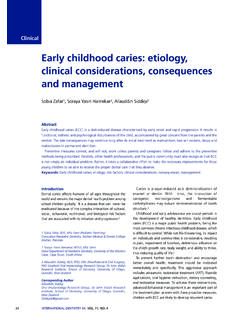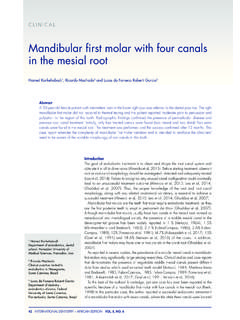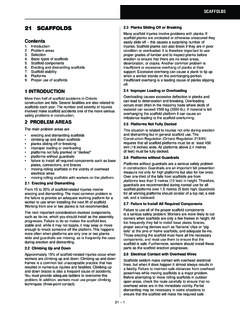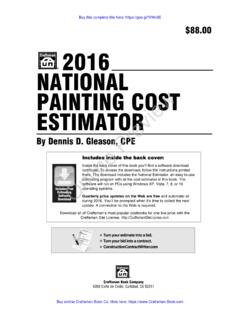Transcription of Bonding to Zirconia: elucidating the confusion
1 Scientific Bonding to zirconia : elucidating the confusion Deepak Mehta,1 Rohit Shetty2. Abstract Optimal surface preparation methods for chemical and/or mechanical Bonding to porcelain substrates are critical to ensure clinical success when placing indirect porcelain restorations, as well as when repairing them intraorally. A variety of surface preparation techniques have been advocated, which includes the use of acids, particle abrasion, adhesives and silane coupling agents. This article will discuss various methodologies currently advocated for the surface treatment of zirconia -based ceramics. Key Words: zirconia , Ceramic Steel, Porcelain, Adhesion Short Title: Bonding to zirconia : elucidating the confusion Introduction dentistry for several years, there has been an increased Ceramic materials are best able to mimic the appearance of interest recently in these materials.
2 zirconia -based natural teeth. As a result of the good properties of dental restorations are versatile and can be used for crowns, ceramics, such as esthetics, chemical resistance, hardness, bridges and implant abutments in a variety of clinical compression resistance and biocompatibility, a significant situations, if the appropriate guidelines are followed. effort has been made over the years to improve their weak points which include brittleness and low tensile ,2 History A progressive improvement in the mechanical The name Zirconium'' comes from Arabic word Zargon''. properties of dental ceramic has led to an increase in which means golden in colour''. Zirconium dioxide (Zro2). metal free restorations. The zirconia systems currently was accidentally identified in 1789 by German chemist, available for use in dentistry include ceramics with a 90% Martin Heinrich Klaproth, while he was working with or higher content zirconium dioxide, which is the yttrium, certain procedures that involved the heating of gems.
3 Stabilized tetragonal zirconia (Y-TZP) and glass infiltrated Subsequently, zirconium dioxide was used as rare pigment ceramics with 35% partially stabilized zirconia . for a long time. The first recommended use of zirconium Though zirconia has been available for use in restorative as a ceramic biomaterial in the form of ball heads for Total Hip Replacements (THR) has been documented. 1 BDS, MDS In the early stages of development, many combinations Reader, Department of Conservative Dentistry & Endodontics of solid solutions (Zro2-MgO, ZrO2-CaO, ZrO2-Y2O3). College & Hospital. Rajiv Gandhi University of Health Sciences, Bangalore, KARNATAKA, INDIA were tested for biomedical application. However, in later years, research efforts concentrated more on the 2 BDS, MDS. Professor, Department of Prosthodontics, Crown & Bridge & development of zirconia -yttria ceramic combinations, Implant Dentistry.
4 KLE Society's Institute of Dental Sciences commonly known as Tetragonal zirconia Polycrystals Rajiv Gandhi University of Health Sciences, Bangalore (TZP). TZP is being used as an application in space KARNATAKA, INDIA. shuttles, automobiles, cutting tools, and combustion Correspondent Author: Dr. Deepak Mehta BDS, MDS engines because of its good mechanical and dimensional Dental Bloom, #10 L-M, 2nd floor, 4th N Block, Dr. Rajkumar Road, Rajajinagar, Bangalore - 560010, KARNATAKA, INDIA. stability, such as mechanical strength and toughness. Ph: 91-9845140082, In vitro evaluation of the mutagenic and carcinogenic 46 INTERNATIONAL DENTISTRY SA VOL. 12, NO. 2. Scientific Table 1. TZP Technical Data Property TZP Material Colour White Chemical compositions Zirconium oxide and Yttrium oxide 3 mol%. Hafnium oxide<2% Aluminium oxide + Silicone oxide<1% Total 100%.
5 Density gcm -3. >6. Porosity % < Bending strength MPa 900-1200. Compression strength MPa 2000. Fracture toughness K1c 7-10. Coefficient of thermal expansion K-1 11 10-6. Thermal conductivity Wmk-1 2. Hardness HV 1200. capacity of high purity zirconia ceramic confirmed that Pure zirconia is monoclinic (M) at room temperature. it did not elicit such effects on the cells. In the 1990s, This phase is stable up to 1170oC. It will transform into a zirconium material was used for endodontic posts and tetragonal (T) phase under higher temperatures and later as implant abutments. This heralded the use of into a cubic phase (C) at 2370o C. zirconium into dentistry. Due to its excellent physical The type of zirconia used in dentistry is yttria tetragonal properties, white color and superior biocompatibility zirconia polycrystal (Y-TZP) material which is zirconia (Table 1), it is being evaluated as an alternative oxide.
6 Yttria (Y2o3) is an oxide of the metallic element framework for full coverage all-ceramic crowns and yttrium (atomic no. 39). fixed partial dentures (FPD). Y-TZP is a monophase ceramic material that is formed by directly sintering crystal together without any Background Concepts in Y-TZP Ceramics: intervening matrix to form a dense, air free, polycrystalline zirconia is the name given to zirconium dioxide (Zro2). structure. The yttria is added to zirconia to stabilize the zirconia is a polycrystalline material, which can exhibit structure and maintain the materials desirable properties more than one crystalline structure depending on pressure (Table 2). and temperature conditions. Another type of zirconia material available is the glass- Table 2. Examples of zirconia -based Ceramics. Product Company Lava Crowns and Bridges 3M ESPE. Cercon Dentsply Ceramco CEREC inLab Sirona inCeram zirconia Vita IPS ZirCAD Ivoclar Vivadent KATANA Noritake Dental Supply Kavo Everest Kavo Procera AllZirkon Nobel Biocare Verus System Whip-Mix ZENO Tec System Wieland Dental + Technik INTERNATIONAL DENTISTRY SA VOL.
7 12, NO. 2 2. Mehta / Shetty Figure 1: SEM images of the Bonding surfaces on zirconia -based ceramic: (a) pretreatment with abrasive paper; (b) air brasion;. (c) silica coating; (d) silica coating after 1-minute cleaning; (e) silica coating after 5 minutes cleaning.(f) SEM image demonstrating the surface of zirconia after completion of SIE the intergrain porosities created on the surface where the primer and the adhesive resin can infiltrate & interlock. (Magnification 2500x). infiltrated zirconia ceramic. This system presents a high crucial to ensure clinical success when placing indirect crystal content of aluminum and zirconium oxide and a ceramic restorations. Although the use of zirconia for limited vitreous phase (20 wt%). dental restoration is ongoing, the best method to Y-TZP Ceramics have a unique characteristic of Stress promote a durable bond between the ceramic and tooth Induced Transformation 3-6 that gives them superior structure is still unknown (Kern & Wegner, 1998).
8 8. mechanical properties compared with other ceramics and Clinicians are often confused regarding the most that is why this material is referred to as a Ceramic Steel effective way to treat the intaglio surface of indirect (Chevalier 1999).4-7 ceramic restoration before placement with various adhesives and luting cements. This is not surprising, as Bonding to Y-TZP Ceramics there appears to be no clear consensus in the dental Optimal surface preparation techniques for chemical literature, from dental manufacturers, on exactly what the and/or mechanical Bonding to ceramic substrates are optimal surface treatment should be. 3 INTERNATIONAL DENTISTRY SA VOL. 12, NO. 2. Mehta / Shetty Table 3. The experimental zirconia primers (Contain 1 vol% functional silane in an ethanol/water solvent system). zirconia Primer Functional Silane Monomer Purity (%). Primer 1 3-Acryloyloxypropyltrimethoxysilane 95.
9 Primer 2 3-Isocyanatopropyltriethoxysilane 95. Primer 3 Styrylethyltrimethoxysilane 92. Primer 4 3-Methacryloyloxypropyltrimethoxysilane > 95. Primer 5 3-(N-Allylamino)propyltrimethoxysilane 95. The lack of clear and consistent guidelines regarding In any case, this technique is very effective (more so the surface treatment of ceramic surfaces raises several than conventional sandblasting) not just with high- significant questions: strength alumina and zirconia based ceramics, but also 1) Is it possible that various viable surface treatment when Bonding to composite14,15 and metal ,17. options exist? Silica coating of metal or composite substrates not only 2) Is it even practical to recommend a specific mechanically roughens the substrates, but also increases Universal treatment protocol because of differences in the number of available hydroxyl groups for surface silane materials (Not all porcelains are the same?
10 Coupling. An attempt to address these questions, provide some It is however, not effective or required with guidelines and also to raise additional questions regarding conventional feldspathic porcelains simply because the management of porcelain surfaces should be made. siginificant amounts of Sio2 and free hydroxyl groups are already present. Bonding to high-content Alumina and zirconia Tribochemical coating is less effective for zirconia core-based Ceramics: ceramics than for glass-infiltrated ceramics (Ernst et al High-content Alumina and zirconia core-based ceramics 2005; Kern M & Wegner SM 1998)1,7 This technique uses are highly resistant to chemical attack from hydrofluoric air pressure which impregnates the ceramic with silica acid (Kern & others)9,10,11,12 and a different approach is particles and further silane application renders the required if clinician elects to bond these restorations using impregnated surface chemically reactive to the resin resin-based adhesives and luting cements (Figure 1).











